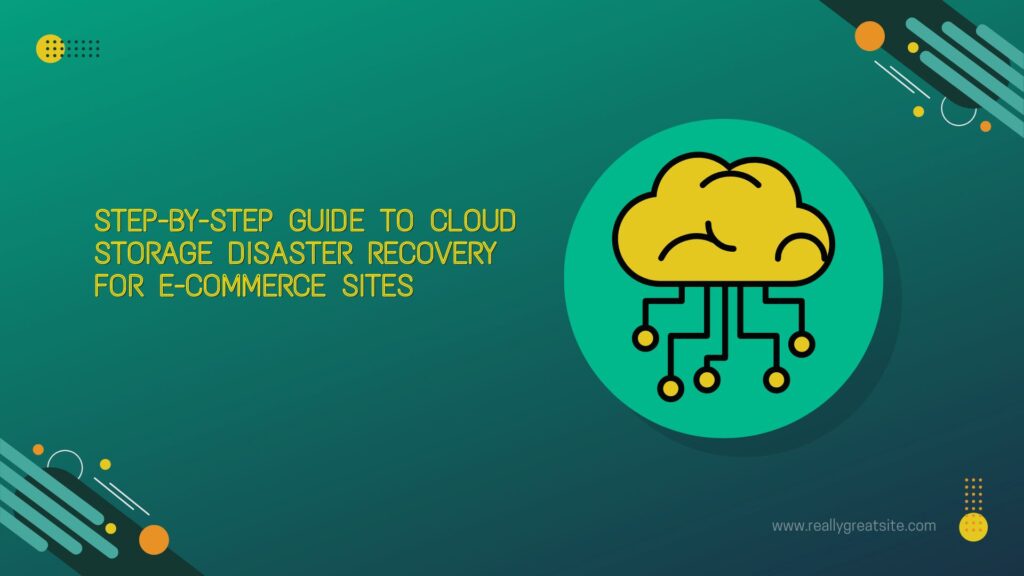Having a solid cloud storage disaster recovery plan for e-commerce sites is absolutely essential.
Let’s face it – running an online business is no easy task, and the last thing you want to worry about is a disaster shutting down your e-commerce site.

Think of it as your safety net. Whether you’re dealing with a sudden server crash, a hacker’s attack, or even a natural disaster, having a reliable backup plan ensures that your site gets back up and running in no time.
In this guide, we’re going to break things down step by step, so it’s easy to understand how to protect your e-commerce business from unexpected disasters.
We’ll start with the basics—like why cloud storage is the best option for storing your data securely—and then move on to practical tips for setting up a recovery system that works. Don’t worry, you don’t need to be a tech genius to follow along!
By the time you’re done reading, you’ll have a clear idea of what cloud storage disaster recovery is, why it’s important for your online store, and how you can implement it without breaking a sweat.
We’ll also share some useful tips on keeping your recovery plan up to date, so you’re always prepared for whatever comes your way.
So, whether you’ve been running an e-commerce site for years or you’re just getting started, stick around.
This guide is all about making sure your business stays safe and your customers happy, no matter what kind of disaster strikes.
Ready to dive in? Let’s get started and show you how easy it is to secure your site with a foolproof cloud storage disaster recovery plan!
Why Cloud Storage Is Your Best Bet for E-Commerce Disaster Recovery
First things first: why should you even bother with cloud storage for disaster recovery? Well, traditional backup systems can be a hassle.
They often rely on physical hardware that can be damaged or lost. Cloud storage, on the other hand, keeps your data safe and sound in off-site servers. This means if something happens to your physical location, your data is still secure.
Here’s why cloud storage is so great:
- Scalability: As your business grows, you can easily increase your storage without much fuss.
- Accessibility: You can get to your backup data from anywhere, anytime—super handy if you’re on the go.
- Cost-effectiveness: You only pay for what you use, so it’s a budget-friendly option compared to big hardware investments.
Got it? Great! Now, let’s dive into how you can set up your disaster recovery plan.
How to Set Up Your Cloud Storage Disaster Recovery Plan
1. Figure Out What You Need
Before jumping into cloud storage, you need to figure out what your e-commerce site actually requires. Think about:
- How much data do you generate each day?
- What data is absolutely critical (like customer info or transaction records)?
- How fast do you need to recover if something goes wrong?
Understanding these points will help you tailor your cloud storage disaster recovery plan for e-commerce sites to fit your needs.
2. Pick the Right Cloud Storage Provider
Next up, you need to choose a cloud storage provider. This can make a big difference in how well your recovery plan works. Look for providers that offer:
- Automatic Backups: Make sure your data is backed up regularly without you having to lift a finger.
- Strong Security: Look for features like encryption and multi-factor authentication to keep your data safe from hackers.
- Reliable Uptime: You want a provider that has a good track record for being up and running, so you can get back online quickly.
Some top choices for cloud storage include Amazon Web Services (AWS), Google Cloud, and Microsoft Azure. Each has its perks, so choose what fits your needs best.
3. Set Up a Backup Schedule
Having a backup schedule is crucial. It’s like having a regular check-up to keep everything running smoothly. Decide how often you need to back up your data based on how often it changes:
- Daily Backups: Great for sites with lots of transactions or frequent updates.
- Weekly Backups: Works well for sites with less frequent updates.
Automating your backups helps you avoid the hassle of remembering to do it manually.
4. Test Your Recovery Plan
Creating a plan is just the start. You need to make sure it actually works. Here’s how to test it:
- Simulated Outages: Try turning off parts of your system to see how quickly your cloud storage can restore data.
- File Recovery Tests: Check if you can recover different files from your backups.
Testing regularly (say, every few months) helps ensure your cloud storage disaster recovery for e-commerce sites is reliable.
5. Keep Your Plan Updated
Your e-commerce site isn’t static, so your disaster recovery plan shouldn’t be either. As your business grows and changes, make sure to:
- Monitor Storage Needs: If you add new features or get more customers, you might need more storage or different backup frequencies.
- Adjust Backups: Make changes to your backup schedule as needed to keep up with your site’s growth.
Staying proactive about updates helps ensure your recovery plan stays effective.
Best Practices for Cloud Storage Disaster Recovery for E-Commerce Sites
Here are a few extra tips to keep your cloud storage disaster recovery for e-commerce sites on point:
- Use Redundant Backups: Store copies of your data in multiple locations to add an extra layer of protection.
- Encrypt Sensitive Information: Protect customer and transaction data with encryption to keep it secure from breaches.
- Set Recovery Time Objectives (RTO): Know how quickly you need to be back online and aim to meet that goal.
Ready to Strengthen Your Cloud Storage Disaster Recovery for E-Commerce Sites?
Implementing a cloud storage disaster recovery plan for e-commerce sites is one of the smartest moves you can make for your business. It helps ensure that, no matter what happens, your online store can recover quickly and keep your customers happy.
Start by assessing your needs, picking the right provider, setting up a backup schedule, testing your plan, and keeping it updated. These steps will help you safeguard your data and stay ahead of any potential problems.
Don’t wait until disaster strikes—take action now (click here) to protect your e-commerce site. Choose a reliable cloud storage provider and set up your disaster recovery plan today. Your business will thank you for it!










